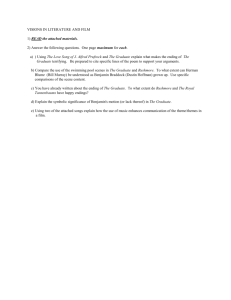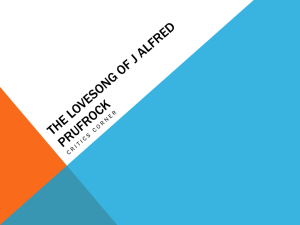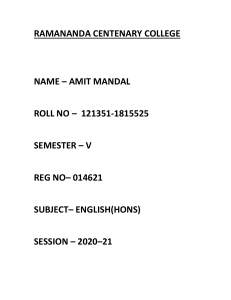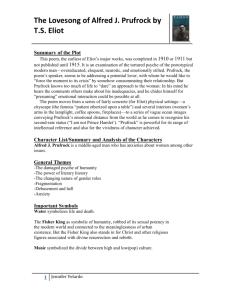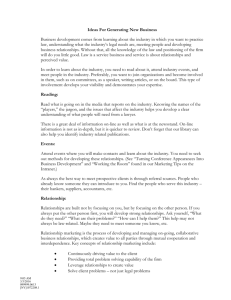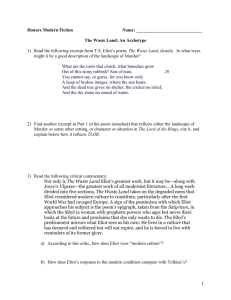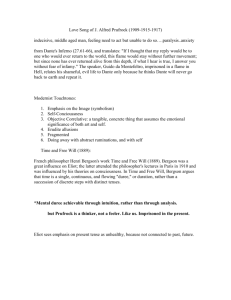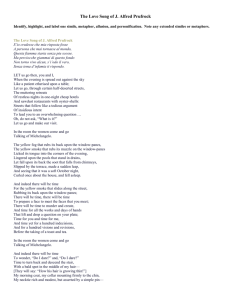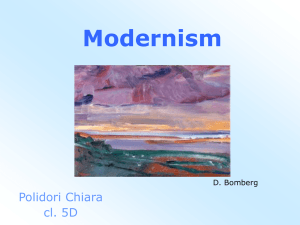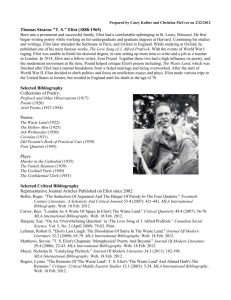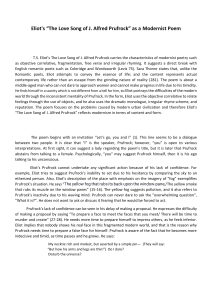The love Song of J. Alfred Prufrock
advertisement
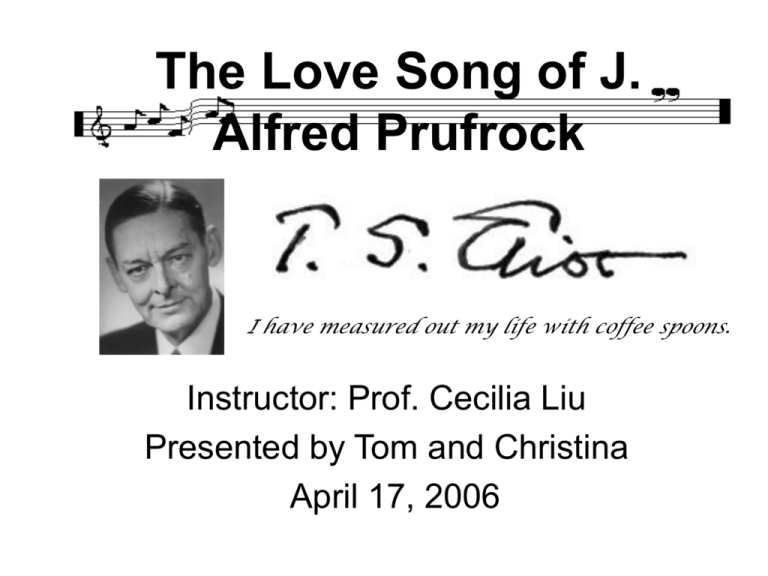
The Love Song of J. Alfred Prufrock I have measured out my life with coffee spoons. Instructor: Prof. Cecilia Liu Presented by Tom and Christina April 17, 2006 Outline 1. The introduction of T. S. Eliot 2. Arrangements 3. Rhyming techniques 4. Interpretations and connotations The Introduction of T. S. Eliot • Family background: Thomas Stearns Eliot (1888-1965) was born in St. Louis, Missouri, of an old New England family. • Influence: One of the most daring innovators of twentieth-century poetry. (Source) T. S. Eliot • He was an American living in London • His father was a successful businessman • His grandfather Eliot moved to St. Louis and had founded Washington University (Source) T. S. Eliot • He attended Harvard (1906-10, 1911-14) • Studied at the Sorbonne in Paris from 1910-11 • Oxford from 1915-16 (Source) T. S. Eliot • Pound introduced him “trained himself and modernized himself on his own” • He settled in England, Marrying Vivian Haigh-Wood in 1915 • Separated in 1932, they never divorced • He married his assistant, Valerie Fletcher, in 1957 (Source) T. S. Eliot • Worked in London as a teacher from 1917-1925 in the foreign department • Had a mental collapse brought by overwork, marital problems, and general depression • Never became a popular poet, despite his tremendous impact on the teaching and writing of poetry • Although remained a resident in England, he returned to the States frequently to lecture and to give readings of his poems. (Source) Arrangements • • A variation on the dramatic monologue Dramatic monologue (according to M.H. Abrams) 1. The utterances of a specific individual (not the poet) at a specific moment in time. 2. Specifically directed at a listener or listeners whose presence is not directly referenced but is merely suggested in the speaker’s words. e.g. “Let us go then, you and I” 3. The primary focus is the development and revelation of the speaker’s character (indecision and isolation). (Source) Rhyming Techniques • Irregular but not random • The use of refrains (chorus) e.g. In the room the women come and go Talking of Michelangelo. • The use of fragments of sonnet form in the conclusion: The three three-line stanzas are rhymed as the conclusion of a Petrarchan sonnet would be (Source) Interpretations and Connotations S’io credesse che mia risposta fosse A persona che mai tornasse al mondo, Questa fiamma staria senza piu scosse. Ma perciocche giammai di questo fondo Non torno vivo alcun, s’i’odo il vero, Senza tema d’infamia ti rispondo. ---an Italian quotation from Dante's Inferno (XXVII, 61-66) ============================================ If I believed that my answer would be To someone who would ever return to earth, This flame would move no more, But because no one from this gulf Has ever returned alive, if what I hear is true, I can reply with no fear of infamy. (Source) Let us go then, you and I, When the evening is spread out against the sky Like a patient etherised upon a table; Let us go, through certain half-deserted streets, The muttering retreats Of restless nights in one-night cheap hotels And sawdust restaurants with oyster-shells: Streets that follow like a tedious argument Of insidious intent To lead you to an overwhelming question … Oh, do not ask, “What is it?” Let us go and make our visit. ========================================================= etherised: to treat or anesthetize with ether sawdust: The small particles of wood or other material that fall from an object being sawed. insidious: malicious (Source) In the room the women come and go Talking of Michelangelo. ======================================================= Eliot imitates Laforgue who wrote, “In the room the women come and go/ Talking of the masters of the Sienne school” The yellow fog that rubs its back upon the window-panes, The yellow smoke that rubs its muzzle on the window-panes, Licked its tongue into the corners of the evening, Lingered upon the pools that stand in drains, Let fall upon its back the soot that falls from chimneys, Slipped by the terrace, made a sudden leap, And seeing that it was a soft October night, Curled once about the house, and fell asleep. =============================================== yellow: the yellow color represents timidity fog: According to Eliot, the smoke that blew across the Mississippi from the factories of St. Louis, his hometown. muzzle: mouth and nose (Source) In the room the women come and go Talking of Michelangelo. And indeed there will be time To wonder, ‘Do I dare?’ and, ‘Do I dare?’ Time to turn back and descend the stair, With a bald spot in the middle of my hair— (They will say: “How his hair is growing thin!”) My morning coat, my collar mounting firmly to the chin, My necktie rich and modest, but asserted by a simple pin— (They will say: “But how his arms and legs are thin!”) Do I dare Disturb the universe? In a minute there is time For decisions and revisions which a minute will reverse. ====================================================== (Source) For I have known them all already, known them all — Have known the evenings, mornings, afternoons, I have measured out my life with coffee spoons; I know the voices dying with a dying fall Beneath the music from a farther room. So how should I presume? ====================================================== a dying fall: In Shakespeare's Twelfth Night the lovesick Duke Orsino orders an encore of a moody piece of music: "That strain again! It had a dying fall". (Source) And indeed there will be time For the yellow smoke that slides along the street, Rubbing its back upon the window-panes; There will be time, there will be time To prepare a face to meet the faces that you meet; There will be time to murder and create, And time for all the works and days of hands That lift and drop a question on your plate; Time for you and time for me, And time yet for a hundred indecisions, And for a hundred visions and revisions, Before the taking of a toast and tea. ====================================================== indeed there will be time: Echoing "Had we but world enough and time", from Andrew Marvell's "To His Coy Mistress" (Source) And I have known the eyes already, known them all— The eyes that fix you in a formulated phrase, And when I am formulated, sprawling on a pin, When I am pinned and wriggling on the wall, Then how should I begin To spit out all the butt-ends of my days and ways? And how should I presume? ========================================================== sprawling on a pin: In the study and collection of insects, specimens are pinned into place and kept in cases. Prufrock feels as though he is being brutally analyzed in a similar manner. butt-ends: As in the ends of smoked cigarettes. (Source) And I have known the arms already, known them all— Arms that are braceleted and white and bare (But in the lamplight, downed with light brown hair!) It is perfume from a dress That makes me so digress? Arms that lie along a table, or wrap about a shawl. And should I then presume? And how should I begin? . . . . . . ====================================================== Arms that are braceleted and white and bare: “A bracelet of bright hair about the bone” in John Donne's “The Relic” (Source) Shall I say, I have gone at dusk through narrow streets And watched the smoke that rises from the pipes Of lonely men in shirt-sleeves, leaning out of windows?… I should have been a pair of ragged claws Scuttling across the floors of silent seas. . . . . . . (Source) And the afternoon, the evening, sleeps so peacefully! Smoothed by long fingers, Asleep … tired … or it malingers, Stretched on the floor, here beside you and me. Should I, after tea and cakes and ices, Have the strength to force the moment to its crisis? But though I have wept and fasted, wept and prayed, Though I have seen my head (grown slightly bald) brought in upon a platter, I am no prophet—and here’s no great matter; I have seen the moment of my greatness flicker, And I have seen the eternal Footman hold my coat, and snicker, And in short, I was afraid. (Source) And would it have been worth it, after all, After the cups, the marmalade, the tea, Among the porcelain, among some talk of you and me, Would it have been worth while, To have bitten off the matter with a smile, To have squeezed the universe into a ball To roll it toward some overwhelming question, To say: “I am Lazarus, come from the dead, Come back to tell you all, I shall tell you all”— If one, settling a pillow by her head, Should say: “That is not what I meant at all. That is not it, at all.” (Source) And would it have been worth it, after all, Would it have been worth while, After the sunsets and the dooryards and the sprinkled streets, After the novels, after the teacups, after the skirts that trail along the floor— And this, and so much more?— It is impossible to say just what I mean! But as if a magic lantern threw the nerves in patterns on a screen: Would it have been worth while If one, settling a pillow or throwing off a shawl, And turning toward the window, should say: “That is not it at all, (Source) That is not what I meant, at all.” . . . . . No! I am not Prince Hamlet, nor was meant to be; Am an attendant lord, one that will do To swell a progress, start a scene or two, Advise the prince; no doubt, an easy tool, Deferential, glad to be of use, Politic, cautious, and meticulous; Full of high sentence, but a bit obtuse; At times, indeed, almost ridiculous— Almost, at times, the Fool. (Source) I grow old … I grow old … I shall wear the bottoms of my trousers rolled. Shall I part my hair behind? Do I dare to eat a peach? I shall wear white flannel trousers, and walk upon the beach. I have heard the mermaids singing, each to each. I do not think that they will sing to me. I have seen them riding seaward on the waves Combing the white hair of the waves blown back When the wind blows the water white and black. We have lingered in the chambers of the sea By sea-girls wreathed with seaweed red and brown Till human voices wake us, and we drown. (Source) References and Sources Biography of T. S. Eliot: <http://nobelprize.org/literature/laureates/1948/eliot-bio.html>. <http://www.literature-awards.com/nobelprize_winners/tseliot_biography.htm>. The English translation of the Italian epigraph: <http://en.wikipedia.org/wiki/The_Love_Song_of_J._Alfred_Prufrock>. Picture sources: <http://images.search.yahoo.com/search/images?p=T.S.Eliot&sm=Yahoo%21+Search&fr =FP-tab-img-t&toggle=1&cop=&ei=UTF-8>. Farley, David. “The Doctor Fun Archive.” 6 Feb. 2002. 17 Apr. 2006 <http://www.ibiblio.org/Dave/ar00355.htm>. Sound information: <http://www.usask.ca/english/prufrock/prustart.htm>. Study guide to “The Love Song of J. Alfred Prufrock”: <http://www.sparknotes.com/poetry/eliot/section1.html>. Stoicheff, Peter. “The Prufrock Papers ~ A Hypertext Resource for "The Love Song of J. Alfred Prufrock.” 23 Aug. 1999. 17 Apr. 2006 <http://www.usask.ca/english/prufrock/index.html>.
